Furnishing for Flexibility
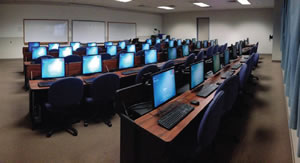
PHOTO COURTESY OF COMPUTER COMFORTS
Seamless use of technology, swift transitions back and forth between individual and collaborative work, meeting instructors’ and students’ expectations: the right furniture can enhance each of these things, not only in classrooms but also in other diverse spaces across campuses today.
Indeed, furniture is part of a changing scene in terms of teaching and learning approaches and the spaces to match. “It’s an evolution, yes, but more a revolution,” says Frank Kolavo, president of Computer Comforts, Inc. “It’s so dynamic.”
Such dynamism includes changes in curricula, funding environments and technology, among others. In another sense, there are long-term changes as well as, in some situations, from hour to hour, as in when a given class period has time for lectures as well as group work, or accommodates different methods from class to class.

PHOTO COURTESY OF AMERICAN SEATING
Technology Spaces
Take computer labs, for example. Among the pieces that signal the trend are team tables with “switching technology that allows small groups to share a large display,” according to Kolavo, whose firm supplied such a system recently to the College of Southern Nevada. And in another example, tables with convertible surfaces — which by lowering and raising monitors into tabletops turn computer labs into multipurpose classrooms and vice versa — offer a feature that can be a boon for crowded campuses, and for instructors trying to rivet the attention of students who otherwise could be surfing the Internet during lectures, explains Kolavo. Such versatility can make a key difference when building, expanding or renovating spaces are financially not in the cards, he points out.
Whatever the teaching and learning space, the process of envisioning and procuring flexible furniture to match the needs of today and tomorrow is multi-faceted. Sarah Zielinski, product marketing manager, architectural environments, for American Seating, says there’s a continuing emphasis by campus facilities managers and others on furniture that’s responsive to the needs for flexibility and durability, that’s affordable, and that is adept for hybrid spaces, which have areas with fixed and moveable furnishings to accommodate various teaching styles and technologies.
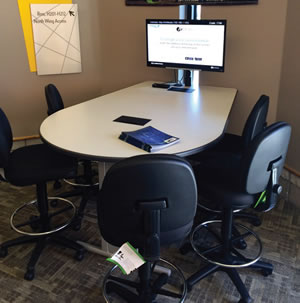
PHOTO COURTESY OF COMPUTER COMFORTS
Appealing to Students
In another dynamic, there’s recruitment. That is, furniture that signals that it is attuned to young people. “We need to take into account that students want something different from high school,” Zielinski says. And the response can encompass form as well as function. The tried-and-true tabletarm chair, a campus staple, can be made available in vivid colors, can sit on casters and have a cup holder, as well as short- and longer-term storage in the form of a side rack and a bag hook — as in when student arrives; opens up a book bag; places a laptop, other equipment, notebooks and books in the rack; hangs a book bag on the chair and goes to work. This design keeps large bags off the floor. It can be surmised that in turn, the capability helps keep floor space clear for easier movement of chairs around a room, as students move from traditional seating arrangements to discussion circles to collaborative work and back again.
Flexibility can also be fixed, so to speak. Zielsinki adds that her company offers a floor-mounted, fixed lecture product — the system is at work at Rutgers University, for example — that has an option telling of changes today: she says that “the chairs swivel 360 degrees to allow collaboration with peers behind you.”
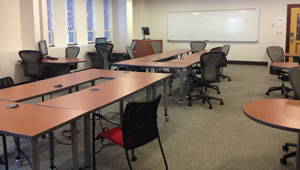
PHOTO COURTESY OF COMPUTER COMFORTS
Libraries, Lounges and Living Spaces
Elsewhere, changes in how student lounges and libraries are used are also spurring responses. For example, Joe A. Agati, president of Agati Furniture, points out that while informal collaborative work has always happened on campuses, that tendency can be enhanced with furniture that invites its use by being comfortable and functional. Customizable media centers, for example, can pair with a variety of upholstered bench furniture to enable collaborative multiple user data options.
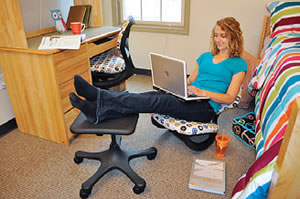
PHOTOS COURTESY OF ALEXA LAMBRIGHT
Active furniture is also appearing in student residences. For example, task chairs are available that allow the seat to be detached from its base to become a floor rocker; and the base a low table for a laptop or a bowl of snacks (shown below). Seemingly simple, so much so that “it’s amazing that no one had thought of it” before, says Sheila Baumgartner, education marketing manager for Sauder Education, Sauder Manufacturing Co. She points out that the chair speaks to the fact that students’ rooms in residence halls tend to be small, and handy approaches to save space and create options can make a key difference. Some of those dynamics were also at play at the University of Cincinnati, where according to the university, Housing& Food Services staff members worked with Blockhouse Contract Furniture to create an expandable dresser-desk to save space in a recently renovated student residence. The dresser conceals a desk surface that is pulled out for use and retracted for storage (shown above). The furniture also has a lockable top drawer, two USB ports, a surge protector and a nine-foot electrical cord to enable more options for placement. Space was saved, as was money: according to the university, using the combo instead of buying two separate pieces “saved the University of Cincinnati $90,000” on the project.
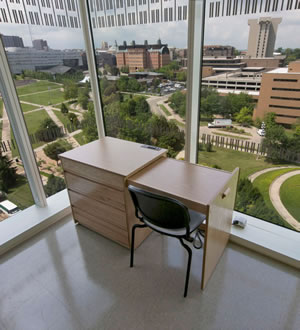
PHOTO COURTESY OF JAY YOCIS, UNIVERSITY OF CINCINNATI CREATIVE SERVICES
EVERYTHING IN ITS PLACE. Flexible furnishings are not limited to classrooms, labs and other learning spaces. Residence hall furniture must be selected for both durability and flexibility. Students will notice and appreciate the ability to personalize and reconfigure rooms quickly and easily to fit individual needs and lifestyles. Furniture that can service more than one function in a relatively compact space is a good choice for residence halls.
Thus, the process of furnishing dynamic spaces is itself dynamic — requiring plenty of thought in order to meet changing needs. Whatever the shapes of things to come, they’re coming. As Kolavo adds, “there’s clearly a movement afoot.”
SOME TIPS ABOUT FURNITURE FOR ACTIVE LEARNING
- Choose furniture that is technology- and vendor-neutral, says Computer Comforts’ Frank Kolavo. It will create options amid changes to come.
- Be aware of the growing range of contingencies for any space. As American Seating’s Sarah Zielinski observes, what are the room’s technology needs and how could they change? Will teaching style in a room change for the term or by class, or even within a class? Will it be a hybrid classroom with fixed as well as loose areas?
- Talk to others who have active furniture about its use, versatility, wear and tear and warranties, says Kolavo.
- Don’t overdo it. Flexibility is very desirable along many lines, but keep things within limits, recommends Agati Furniture’s Joe Agati.
This article originally appeared in the issue of .